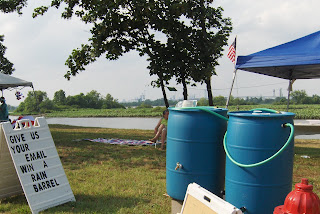How Do You Make Compost?
The beauty of making compost is that it is so simple and easy. You use materials that you have in your home and yard. It does not have to be an exact science. Think of a forest floor – it is covered with layers of materials that have fallen there naturally, over the seasons, and they have decomposed into a fluffy, fragrant, rich soil.
To get you started, here are some basic guidelines to follow.
Start by making or buying a
compost bin. This can be as simple as making an open bin, in a 3 or 4 feet in diameter circle, out of welded wire or plastic garden fencing. Or you can purchase a compost bin, which will come with a lid. Using a lid speeds up the composting process.
Put your compost bin on the ground, in an easily accessible place. It should be near a water source because you will have to keep your compost pile moist. And it should be in a semi-sunny location.
Add ingredients. Start with a 4 inch layer of chopped leaves and stemmy plants, sticks, or other coarse material on the bottom.
Then, add kitchen wastes, dead plants, and chopped leaves, as they become available.
In your kitchen, keep a small pail or some type of washable container to collect your food scraps.
Make regular trips out to your compost pile and mix your kitchen scraps into the existing pile.
Your compost pile should be a mix of carbon-rich materials, your “browns,” and nitrogen-rich materials, your “greens.” Aim for 2 parts browns to 1 part greens.
Your carbon or brown materials are dried leaves, sticks and dead plants.
Your nitrogen or green materials are fresh or green, such as kitchen scraps.
Good Compost IngredientsLeaves, and other dead plant material
Grass clippings ( * NOTE – As an alternative to collecting grass clippings, leave them on your lawn after mowing. They are an excellent way to naturally feed and mulch your lawn. Grass clippings do not cause “thatch”. Clippings are 90% water and decompose very quickly) Fruit and vegetable trimmings
Fruit rinds, peels, cores, egg shells
Coffee grinds & filters, tea bags
Manure from horses, cattle, goats, poultry and rabbits (optional)
Bad Compost Ingredients DO NOT USE
Meat scraps
Fat or butterFatty, sugary or salty foods
Chips or sawdust from treated wood
B-B-Q or charcoal ash
Wood ashClippings from herbicide-treated lawnsManure from dogs, cats or humans
Add water to your compost pile as often as needed to keep the material moist but not soggy (like a wrung-out sponge).
Turning the pile is helpful but optional.
The compost is ready to use when you can no longer recognize the original ingredients. A compost pile is an ongoing activity. You keep adding to it from the top, and you remove your compost from the bottom.





